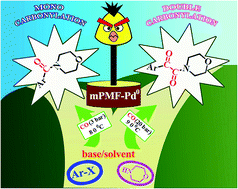Mesoporous poly-melamine-formaldehyde stabilized palladium nanoparticle (Pd@mPMF) catalyzed mono and double carbonylation of aryl halides with amines†
Abstract
A new mesoporous poly-melamine-formaldehyde material supported Pd nano catalyst (mPMF–Pd0) has been synthesized and characterized by thermogravimetric analysis (TGA), powder X-ray diffraction (XRD), scanning electron microscopy (SEM), energy dispersive X-ray spectrometry (EDS), high-resolution transmission electron microscopy (HRTEM), UV-vis diffuse reflection spectroscopy (DRS), Raman spectroscopy, X-ray photoelectron spectroscopy (XPS) and a N2 adsorption study. The mPMF–Pd0 material showed very good catalytic activity in the field of mono and double amino carbonylation of aryl bromides/iodides. Moreover, the catalyst is easily recoverable and can be reused six times without appreciable loss of catalytic activity in the above reactions. So, the highly dispersed and strongly bound palladium(0) sites in the mPMF–Pd0 could be responsible for the observed high activities. Due to strong binding with the functional groups of the polymer, no evidence of leached Pd from the catalyst during the course of reaction occurred, suggesting true heterogeneity in the catalytic process.


 Please wait while we load your content...
Please wait while we load your content...